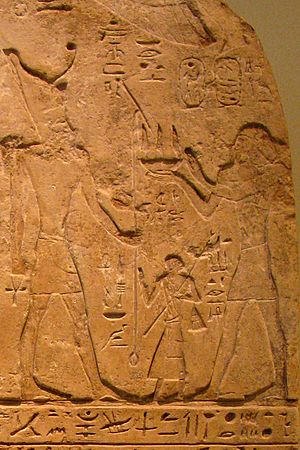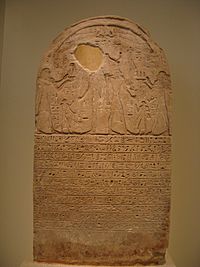Tefnakht facts for kids
Quick facts for kids Tefnakht |
|
|---|---|

Tefnakht on his year 8 stela
|
|
| Pharaoh | |
| Reign | 732–725 BC (24th Dynasty) |
| Predecessor | Interregnum (as a pharaoh) Osorkon C (as a Great Chief of the Ma) Ankhhor (as a Great Chief of the West) |
| Successor | Bakenranef |
| Children | Bakenranef |
| Father | Gemnefsutkapu |
Shepsesre Tefnakht was an important ancient Egyptian leader. He started the 24th Dynasty of pharaohs. He was a prince from a city called Sais in the western part of Egypt. Tefnakht ruled for about seven years, from 732 BCE to 725 BCE. He began his career as a powerful chief in the western Delta region.
A recently found statue tells us more about his family. It shows that Tefnakht's father was named Gemnefsutkapu. His grandfather was Basa, a priest. This means Tefnakht came from a family of priests, not from the traditional chief families as once thought.
Tefnakht's Rise to Power
Tefnakht became a prince in Sais during the time of Shoshenq V, the last ruler of the 22nd Dynasty. He set up two special stone tablets, called stelas, in Shoshenq V's 36th and 38th years as king. One of these stelas, found in Buto, is very important. It shows Tefnakht calling himself the "Great Chief of the entire land."
This stela also lists his religious titles, like "prophet of Neith." This shows that even before the 22nd Dynasty ended, Tefnakht already controlled important cities like Sais, Buto, and Kom el-Hish. This means he had a strong base in the western Delta region of Egypt.
The 22nd Dynasty was losing its power even before Shoshenq V died. Tefnakht made Sais his capital city. He then formed alliances with other small kings in the Delta region. His goal was to take control of Middle and Upper Egypt, which were ruled by the Nubian king Piye.
Tefnakht was very successful. He managed to capture and unite many cities in the Delta. This made him much more powerful than any leaders before him.
Challenges and Conflicts
Tefnakht was not part of the 22nd Dynasty, which was based in a city called Tanis in the eastern Delta. His city, Sais, was in the western Delta, closer to Libya. His title, "Great Chief of the West," also suggests he wasn't from a royal family.
Before he became a king, Tefnakht expanded his control south. He captured the important city of Memphis. He also tried to take Herakleopolis, a city that was an ally of King Piye of Nubia. This led to a big conflict with Piye.
One of Piye's allies, Nimlot, the ruler of Hermopolis, switched sides and joined Tefnakht. However, Piye's navy soon stopped Tefnakht's forces from moving further into Piye's lands. Piye quickly recaptured Memphis.
After more battles, Tefnakht's allies surrendered to Piye. Tefnakht found himself alone. He eventually sent a letter to Piye, promising his loyalty. But Tefnakht was the only Lower Egyptian prince who avoided meeting Piye face-to-face. These events are described on a large stone tablet called the Great Victory stela of Piye. After these victories, Piye returned to Nubia and never came back to Lower Egypt.
Tefnakht Becomes King
Even though he faced setbacks, Tefnakht remained the local prince of Sais. After Piye left Lower Egypt, there was a power gap. Tefnakht used this chance to rebuild his kingdom's control in the Delta region.
Most experts believe that Prince Tefnakht officially declared himself king Shepsesre Tefnakht I. He took on royal titles sometime after Piye left Lower Egypt. His son, Bakenranef, later became his successor in Sais.
Some scholars have debated if the king Shepsesre Tefnakht mentioned on a stone tablet from Athens was Tefnakht I or a later king named Tefnakht II. However, most experts today still believe that this tablet belongs to Tefnakht I. This means he was indeed the founder of the 24th Dynasty.
See also
 In Spanish: Tafnajt para niños
In Spanish: Tafnajt para niños


